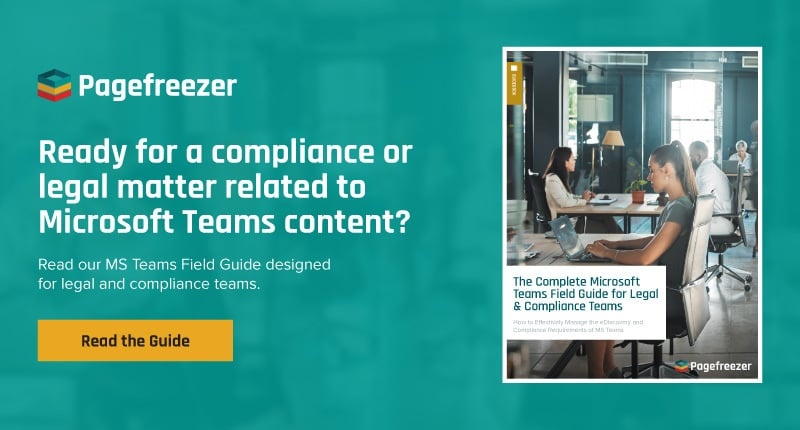From access control to data retention, if you are trying implement a new enterprise collaboration or internal chat platform, your compliance team will have critical questions that must be addressed to avoid potential legal and regulatory issues.
Enterprise collaboration tools (ECTs) have become ubiquitous in modern organizations, and for good reason — they facilitate and enhance communication and productivity, especially with remote work becoming more common. However, introducing these tools can create significant compliance challenges.
One key challenge is that the copious amounts of data created in these platforms can lead to compliance issues that have the potential to spiral out of control.
While enterprise team collaboration tools have the capacity to generate an ocean of unstructured data, there’s no reason for businesses to miss out on the many benefits they offer. (The smart solution is an enterprise-grade archiving software that can help organizations collect, store, and monitor their ETC data.)
Here's a breakdown of four key questions your compliance team will ask—and how you can prepare answers to ensure a smooth implementation.
1. Who Will Use the Platform and How Will Access Be Managed?
ECT compliance needs form a strong element of a business’s internal communication policies – it’s important to know exactly who is using the platform, and how.
Compliance teams will want to know who’s using the platform, especially if regulated employees or contractors are involved. When it comes to access control of your ECT channels, specificity can make a huge difference. It's essential to set access levels—are some channels open to everyone, while others are invite-only? Will contractors have limited access? Clear policies avoid confusion and ensure everyone knows their role.
Mandatory Staff Training For Enterprise Collaboration Tools
Don’t make the assumption employees will know how to use your collaboration platform within set the limits. Reassure your compliance team by letting them know you’ll leave nothing to chance when it comes to communicating your expectations of how the platform is to be used. Assigning mandatory training sessions that teach employees about the acceptable use of a collaboration platform is a great way of ensuring this.
Mandatory training is a good opportunity to discuss organizational policies more broadly. Walk users through the acceptable use procedures of the enterprise team collaboration platform to eliminate confusion later on, and demonstrate how this factors into the broader context of your business’s policies. Throughout the training, your organization should communicate the defined acceptable use policies of the platform to ensure respectful behavior reducing the liability of bullying, obscene, or profane messages.
If production managers have access to employees’ conversation channels and private messages, the policies relating to this should be clear. For instance, you can set up a security policy that instructs the monitoring and protection of sensitive data on internal channels. Organizations can even limit the number of individuals who can post on company channels to avoid disruptions.
2. How Long Will You Retain Data—and Why?
ECTs regularly generate huge amounts of unstructured data.
Sure, data is power, but organisations need to be able to preserve, control, and produce records of this unstructured data for it to be useful and to meet compliance requirements. Compliance standards vary across industries, with some requiring specific retention periods.
Data Retention and Data Preservation: What’s the difference?
Technically, data retention refers to the information governance and management of records. Whether it’s healthcare or finance, most sectors have specific regulations about data retention.
Financial services for example, have to maintain communication records to meet the recordkeeping requirements of FINRA and SEC.
Data preservation, on the other hand, is associated with litigation and eDiscovery. Companies should always assume the possibility of litigation and have measures in place to preserve any data that may be requested as the result of a legal case.
Enterprise Archiving Software
A common solution to unstructured data retention compliance requirements is implementing an enterprise archiving software that can automate all of these procedures for you. With automated retention, you don't have to ask compliance teams to manually delete records. You can store data for as long as you need and expect automatic deletion right after your specified retention period is complete.
3. How Will Data Be Retained to Meet Regulations?
Compliance teams need assurance that sharing data with regulators won’t be a nightmare. Auditors often require access to specific records—fast. With the right archiving solution, you can archive data in formats like PDF or WARC and generate shareable links for auditors. This makes handing over records smooth and secure, eliminating unnecessary back-and-forth.
Data Security
Any data archiving solution you implement should adheres to the SOC 2 standard to maintain operational security. Enterprise-grade solutions should meet the ISO 27001:2013 certified standards to collect, maintain, and update data. This security certification also includes authorizing data access to specific users and protecting the integrity of data by preventing unauthorized modifications.
Meeting WORM Recordkeeping Rules
According to SEC Rule 17a-4(f), financial services organizations need to maintain the records of stored information on their channels and media in a non-erasable and non-writable format. In 2016, FINRA fined 12 firms a total of $14.4 million for failing to maintain electronic records in “write once, read many,” or WORM, format, which prevents the alteration or destruction of records stored electronically.
WORM requirements stipulated in SEC Rule 17-a4 (f) can get quite technical, but essentially require businesses to store data in a manner that allows easy export with the inclusion of location details, in a non-erasable, non-rewritable format, ensuring the authenticity of the records. Any records you capture from your ECTs should be stored in WORM format to meet compliance standards.
Accessing Data in Native Formatting
Some compliance standards also include stipulations about ease of access to data and the ability to produce data for auditors swiftly. Preserving each post, comment, reply, image, link and direct conversation as it appeared, in real-time, can also be very helpful for auditors trying to parse the data, adding an additional layer of context to the data they are reviewing.
4. How Will Compliance Teams Monitor and Access Data?
Should compliance teams need it, accessing your data should be easy. Implementing a data archiving solution that has advanced search features, making it easy to pinpoint specific users, dates and messages, will go a long way — you can use it to deliver correct data across any archive, timeline, group, account, or direct conversation.
Being able to set user permissions and grant limited access to specific users or groups to records and comments is essential.
Data Loss Prevention and Monitoring
Enabling keyword monitoring for your enterprise collaboration platform data also means that HR and compliance teams can keep an eye on conversations through predefined text and number patterns. Furthermore, administrators can set alerts based on specific phrases, number patterns, and keywords. This can help your team flag any suspicious behavior, data leaks, or unacceptable language.
Working with Your Compliance Team to Implement an Enterprise Collaboration Tool
Once you have the answers to the key questions listed above, your organization will be able to mitigate various compliance risks associated with ECTs. Of course, having enterprise-grade archiving software is the key to achieving success here.
It's important to note that team-based collaboration and communication tools will continue to evolve. But so long as you have the right enterprise-grade archiving tool in place, it will be easy to collect, control, monitor, and tailor complex unstructured data.









